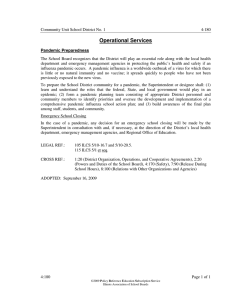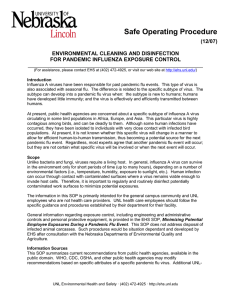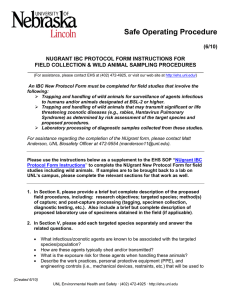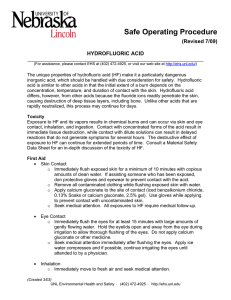Safe Operating Procedure (Revised 4/08) MINIMIZING POTENTIAL EMPLOYEE EXPOSURES
advertisement
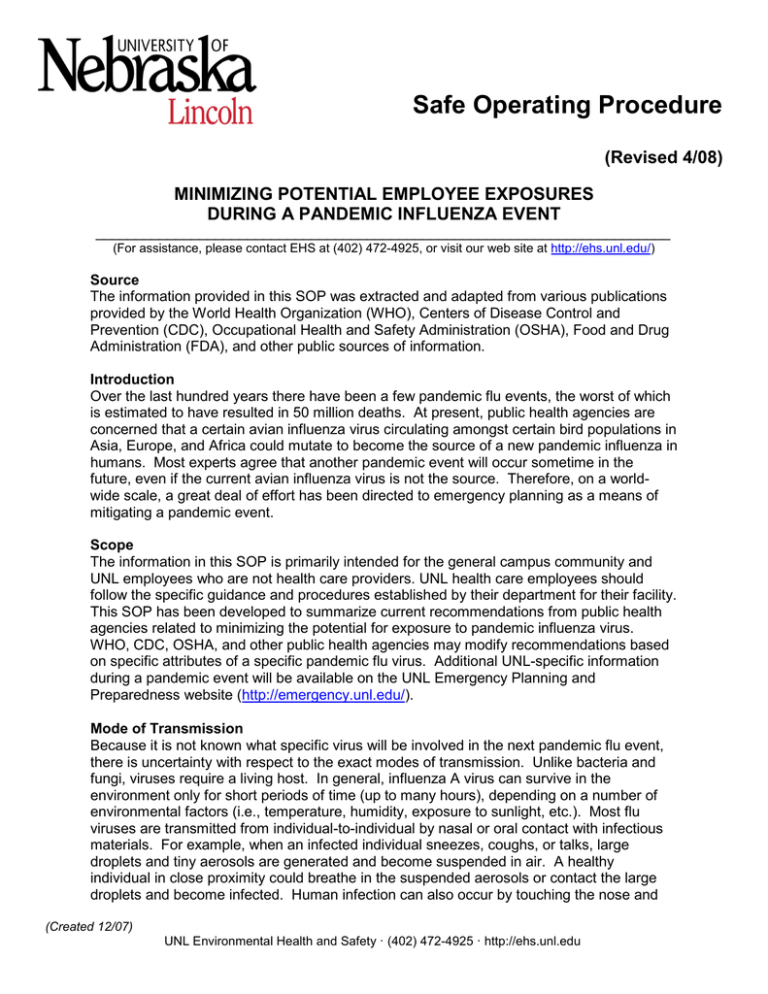
Safe Operating Procedure (Revised 4/08) MINIMIZING POTENTIAL EMPLOYEE EXPOSURES DURING A PANDEMIC INFLUENZA EVENT ________________________________________________________________________ (For assistance, please contact EHS at (402) 472-4925, or visit our web site at http://ehs.unl.edu/) Source The information provided in this SOP was extracted and adapted from various publications provided by the World Health Organization (WHO), Centers of Disease Control and Prevention (CDC), Occupational Health and Safety Administration (OSHA), Food and Drug Administration (FDA), and other public sources of information. Introduction Over the last hundred years there have been a few pandemic flu events, the worst of which is estimated to have resulted in 50 million deaths. At present, public health agencies are concerned that a certain avian influenza virus circulating amongst certain bird populations in Asia, Europe, and Africa could mutate to become the source of a new pandemic influenza in humans. Most experts agree that another pandemic event will occur sometime in the future, even if the current avian influenza virus is not the source. Therefore, on a worldwide scale, a great deal of effort has been directed to emergency planning as a means of mitigating a pandemic event. Scope The information in this SOP is primarily intended for the general campus community and UNL employees who are not health care providers. UNL health care employees should follow the specific guidance and procedures established by their department for their facility. This SOP has been developed to summarize current recommendations from public health agencies related to minimizing the potential for exposure to pandemic influenza virus. WHO, CDC, OSHA, and other public health agencies may modify recommendations based on specific attributes of a specific pandemic flu virus. Additional UNL-specific information during a pandemic event will be available on the UNL Emergency Planning and Preparedness website (http://emergency.unl.edu/). Mode of Transmission Because it is not known what specific virus will be involved in the next pandemic flu event, there is uncertainty with respect to the exact modes of transmission. Unlike bacteria and fungi, viruses require a living host. In general, influenza A virus can survive in the environment only for short periods of time (up to many hours), depending on a number of environmental factors (i.e., temperature, humidity, exposure to sunlight, etc.). Most flu viruses are transmitted from individual-to-individual by nasal or oral contact with infectious materials. For example, when an infected individual sneezes, coughs, or talks, large droplets and tiny aerosols are generated and become suspended in air. A healthy individual in close proximity could breathe in the suspended aerosols or contact the large droplets and become infected. Human infection can also occur by touching the nose and (Created 12/07) UNL Environmental Health and Safety · (402) 472-4925 · http://ehs.unl.edu mouth after contact with a contaminated surface. The eyes are generally less sensitive. Skin is an effective barrier (other than when contaminated skin contacts the nose or mouth) to infection. General Campus Population Social distancing is the preferred method for reducing risk in the general population. In the context of this SOP, “general population” refers to those UNL employees who do not have contact with people known or suspected to be infected with the pandemic virus or frequent close contact (6’ or less) with the public. PPE is generally not recommended for the general population. Appropriate precautions for the general campus population include the following: If available, receive a seasonal influenza vaccine. While the seasonal influenza vaccine is unlikely to protect against new and novel pandemic influenza viruses, it will protect employees from traditional seasonal influenza viruses that continue to circulate. Also receive a pandemic influenza vaccine if it should become available to the general population. Minimize close contact with others, including apparently healthy individuals. Consult with your supervisor regarding alternative work sites and/or schedules. Minimize contact with others when ill and seek medical attention. Do not report to work. Practice good cough etiquette and encourage the same in others. o Cover the mouth and nose with a tissue and dispose of used tissue in waste containers; o Use a mask if coughing (when a mask can be tolerated); o Perform hand hygiene (wash with soap and warm water for 15 seconds or clean hands with alcohol-based hand product if hands are not visibly soiled) after contact with respiratory secretions; and o Stand or sit at least 6 feet from other persons, if possible. Regularly disinfect work surfaces, particularly those that are touched often or by many individuals (i.e., telephones, computer equipment, desks). If possible, avoid “common use” work areas/items/surfaces. During planning, departments should purchase adequate stocks of disinfectants. See EHS SOP, Environmental Cleaning and Disinfection for Pandemic Influenza Exposure Control. Wash hands frequently with soap and water or with hand sanitizer if soap and water are not readily available. Avoid touching eyes, nose, and mouth. Employees at Increased-Risk UNL employees who may be at increased risk of exposure during a pandemic event include those that have frequent, close contact with known or suspected sources of pandemic influenza virus. Depending on specific tasks and conditions of potential exposure, the increase in risk may range from moderate to severe. Examples of UNL employees who may be at increased risk include the following: • Employees who are called upon to provide medical care to patients known or suspected of being infected with pandemic flu virus. Employees who conduct aerosol-generating procedures (e.g., cough induction, invasive specimen collection, bronchoscopies, etc.) are at the highest risk of exposure. UNL health care employees should follow the specific guidance and procedures established by their department for their facility. (Created 12/07) UNL Environmental Health and Safety · (402) 472-4925 · http://ehs.unl.edu • • • • • • Employees who provide transportation services to potentially infected individuals. Employees who manipulate laboratory specimens and cultures known or suspected of containing pandemic flu virus. Employees involved in the culling of potentially infected animal populations or necropsy of dead animals suspected or known to harbor the pandemic flu virus. Employees providing custodial or maintenance services in rooms occupied by individuals known or suspected of being infected. Employees who contact potentially infected animal populations, such as veterinarians, veterinary technicians, veterinary students, animal care technicians, wildlife biologists, etc. Employees with frequent and close contact with the general population Engineering, administrative, work practice controls, and personal protective equipment (PPE) are essential to minimizing potential exposures for employees who are at increased risk. Engineering Controls Appropriate engineering controls are site and task specific. In the context of a laboratory setting, a biosafety cabinet (BSC) is the most basic engineering control. Work with potentially infectious materials must be conducted within a BSC, particularly potential aerosol-generating activities. In the case of employees with frequent and close contact with the general population, an engineering control might be a physical barrier, such as a sneeze guard or plastic sheeting. Upon request, EHS will provide specific engineering control recommendations based on real time needs and situations. Administrative Controls Administrative controls are often referred to as “work practices.” The recommendations provided above for the general campus population are examples of administrative controls. Again, appropriate administrative controls are task and site specific. Upon request, EHS will provide specific administrative control recommendations based on real time needs and situations. Personal Protective Equipment (PPE) In some cases, engineering and administrative controls alone may not be adequate to minimize potential exposures. PPE provides another layer of protection by forming a physical barrier between an individual and the potential source of infection. However, PPE is a supplement to and not a substitute for good hygiene practices and other controls. Various types of PPE are designed to protect different parts of the body from different routes of exposure. For example, safety glasses and goggles protect the eyes and respirators protect the lungs. The appropriate ensemble of PPE is task and site specific. In all cases, for PPE to be effective it must be: Selected based upon the hazard to the employee (EHS evaluates potential exposures and provides recommendations, upon request). Properly fitted to the employee (tight-fitting respirators require fit-testing by EHS). Donned in the proper sequence when using more than one type of PPE: gown, mask or respiratory, goggles or face shield, and gloves. (Created 12/07) UNL Environmental Health and Safety · (402) 472-4925 · http://ehs.unl.edu Conscientiously and properly worn. Regularly maintained. Properly removed and disposed to avoid contamination to self, others, or environmental surfaces. PPE should be doffed in the following sequence: gloves, goggles or face shield, gown, and mask or respirator. Hand washing after removal of PPE is critical. The paragraphs below describe various types of PPE that may be selected to form an appropriate and complete ensemble. All of the items may be appropriate in certain situations, while only a subset of one or more items may be appropriate in other situations. Departments should review their operations to identify employees who may be at increased risk during a pandemic event, with the intent of determining the amount and types of PPE that will be necessary. Ensure that adequate supplies are stocked based on planning assumptions. Suppliers should be able to provide guidance with respect to recommended storage conditions and expected “shelf-life.” Utilize stock rotation procedures. Eye and Face Protection Most influenza viruses are not transmitted very effectively by eye contact. Therefore, eye protection is not required, unless an employee may be exposed to highly concentrated forms of virus (i.e., viral cultures, invasive procedures on an infected host) or other hazards (i.e., chemical contact, flying debris, biological agents effectively transmitted via the eye, etc.). Simple safety glasses can provide a barrier to inadvertent finger-eye contact. Goggles are appropriate when conducting operations with concentrated forms of virus or other hazardous tasks (i.e., mixing or applying chemical disinfectants). Eye protection must meet ANSI standards as indicated by appropriate marking on the protective eyewear. Face shields form a barrier to prevent contact of the nose and mouth of the wearer with large, virus-containing droplets. Face shields also protect facial skin from chemical splashes/splatters and flying debris. Face shields are appropriate when conducting invasive diagnostic or necropsy procedures and when in close (<3’) contact with individuals known to be infected with the pandemic flu virus. Face shields and goggles must be decontaminated between uses. Body/Skin Protection Influenza viruses do not cause infection by simple skin contact. Rather, infection generally occurs when contaminated skin (i.e., fingers) contacts susceptible body parts (i.e., mouth or nose). The main objective of body/skin protection is to prevent the transfer of virus from one contaminated area/item/person to an otherwise “clean” or “uncontaminated” area/item/person. Hence, the most important considerations when using body/skin protection are proper removal (so as to not contaminate underlying clothing and body parts, and before entering clean areas) and disposal. Outer garments and shoe covers are important for infection control in patient care situations. Use will be prescribed by department specific procedures and protocols in health care settings. In other UNL settings, outer garments are appropriate when gross contamination is likely (e.g., when conducting tasks with large volumes of potentially contaminated materials, during surgical or necropsy procedures with infected animals, when engaged in infected animal culling operations, when caring for susceptible animal populations, and similar activities). (Created 12/07) UNL Environmental Health and Safety · (402) 472-4925 · http://ehs.unl.edu Lightweight latex, nitrile, or vinyl gloves, like outer garments, are most useful as an infection control method. Gloves can also help remind individuals who may be exposed to contaminated surfaces to avoid touching their face. Heavier elastomer gloves are necessary to provide chemical protection. Other types of gloves may be necessary to protect against cuts and abrasions or bites and scratches. Disposable gloves should be changed frequently; when compromised by contamination or wear/tear, before leaving a contaminated area and entering a clean area, after handling potentially contaminated materials, and between patient contacts. Disposable gloves should be discarded after use; never washed or decontaminated for reuse. The proper procedure for removing disposable gloves is shown below. Grasp the outside edge of glove near wrist, peel away from hand, turning glove inside-out; hold in opposite gloved hand, slide ungloved finger under the wrist of the remaining glove, peel off from inside, creating a bag for both gloves. Discard. The proper procedure for removing a gown is shown below. Unfasten ties, peel gown away from neck and shoulder, turn contaminated outside toward the inside, fold or roll into a bundle. Discard or place into soiled laundry (whichever is appropriate). Respiratory Protection An effective respirator is the single most important part of a PPE ensemble for employees who are at high risk of exposure to a pandemic influenza virus. Examples of employees in (Created 12/07) UNL Environmental Health and Safety · (402) 472-4925 · http://ehs.unl.edu this category would include employees who: transport patients known or suspected of being infected with pandemic influenza virus; conduct invasive diagnostic or necropsy procedures; come in close (<3’) contact with individuals or animal hosts known to be infected with the pandemic flu virus. Respirators may also be necessary to protect against other hazards such as allergens or chemical mists and vapors, etc. Use of a respirator is subject to requirements of UNL’s Respiratory Protection Program and associated EHS SOPs (see EHS web page). In summary, mandatory use of a respirator requires prior medical qualification, fit-testing, and training. Annual fit-testing and refresher training is also required. Respiratory protection devices come in a variety of types; examples include disposable particulate respirators (commonly referred to as “N95, N99, or N100”), half or full-face air purifying respirators, and supplied air respirators. SOPs published on the EHS web page provide information on proper use and limitations of various types of respirators. At a minimum, NIOSH certified N95 respirators (preferrably with dual FDA clearance) are required for protection against particulate-bound viruses. Regular surgical, dust, isolation, dental, medical procedure, and isolation masks are not the same as N95 respirators and do not protect against inhalation hazards. Particulate respirators, such as N95, N99, and N100) respirators will not protect against other types of hazards, e.g., chemical vapors that may be generated when conducting disinfection. There are no current recommendations for the issuance of respiratory protection to the general employee population, and the inappropriate use of respirators may pose a risk. While discouraged, employees may voluntarily elect to use respirator masks out of personal concern for their own safety, unrelated to any specific exposure scenario. See EHS SOP, Respiratory Protection - Voluntary Use of Respiratory Protection Equipment, for additional information, including applicability of elements of the UNL Respiratory Protection Program. (Created 12/07) UNL Environmental Health and Safety · (402) 472-4925 · http://ehs.unl.edu

